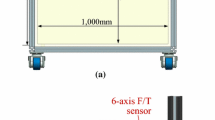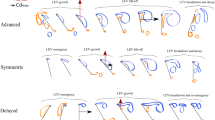Abstract
This paper reports on a fundamental investigation of the effects of pitching phase angle (ϕ) and pitching amplitude (α A) on the aerodynamics of a two-dimensional (2D) flapping wing executing simple harmonic motion in hovering mode. A force sensor and digital particle image velocimetry were employed to obtain the time-dependent aerodynamic forces acting on the wing and the associated flow structures, respectively. Pitching phase angle ranging from 0° to 360° at three different pitching amplitudes, that is, 30°, 45° and 60°, was studied. Our experimental results revealed that the largest lift and lift/drag ratio were achieved under the condition of advanced pitching (ϕ > 90°). However, further increasing ϕ beyond a certain value would not enhance the average lift any more. In contrast, the delayed pitching (ϕ < 90°) would cause the average lift to decrease and generally the averaged drag to increase, compared to the normal pitching (ϕ = 90°), overall reducing the lift/drag ratio greatly. Our experimental results also supported the findings of Lua et al. (J Exp Fluids 51:177–195, 2011) that there are two kinds of wing–wake interactions, and they can either enhance or reduce lift on the wing depending on the wing motion and the timing of the reverse stroke. Our results show that wing–wake interaction of the first kind normally has an adverse effect on lift generation when the wing is undergoing delayed pitching but has a positive effect on the lift when the wing is undergoing advanced pitching motion. When the ϕ became larger, the second kind of wing–wake interaction, that is, sliding of the leading edge vortex under the wing, will cause the concurrent fall in lift and drag.


















Similar content being viewed by others
Abbreviations
- c :
-
Chord length
- C L :
-
Lift coefficient
- C D :
-
Drag coefficient
- f :
-
Flapping frequency
- F A :
-
Instantaneous force parallel to the chord
- F D :
-
Drag
- F L :
-
Lift
- F N :
-
Instantaneous force normal to the chord
- Re :
-
Reynolds number = U rms c/v
- S :
-
Wing platform area
- t :
-
Current time
- t* :
-
Non-dimensional time = t/T
- T :
-
Flapping period
- U max :
-
Maximum heaving velocity
- U rms :
-
Root mean square of the heaving velocity
- α :
-
Instantaneous pitch angle relative to the heaving motion
- ϕ :
-
Phase angle difference between pitching and heaving motion
- v :
-
Kinematic viscosity of the fluid
- ρ :
-
Density of the fluid
References
Birch JM, Dickinson MH (2003) The influence of wing–wake interactions on the production of aerodynamic forces in flapping flight. J Exp Biol 206:2257–2272
Bos FM, Lentink D, van Oudheusden BW, Bijl H (2008) Influence of wing kinematics on aerodynamic performance in hovering insect flight. J Fluid Mech 594:341–368
Bourgoyne DA, Hamel JM, Ceccio SL, Dowling DR (2003) Time-averaged flow over a hydrofoil at high Reynolds number. J Fluid Mech 496:365–404
Dickinson M (1994) The effects of wing rotation on unsteady aerodynamic performance at low Reynolds numbers. J Exp Biol 192:179–206
Dickinson MH, Lehmann F-O, Sane SP (1999) Wing rotation and the aerodynamic basis of insect flight. Science 284:1954–1960
Ellington CP (1984) The aerodynamics of hovering insect flight. 4. aerodynamic mechanisms. Philos Trans R Soc Lond B Biol Sci 305:79–113. doi:10.1098/rstb.1984.0052
Ellington CP, Van Den Berg C, Willmott AP, Thomas AL (1996) Leading-edge vortices in insect flight. Nature 384:626–630
Freymuth P (1990) Thrust generation by an airfoil in hover modes. Exp Fluids 9:17–24
Lua KB, Lim TT, Yeo K, Oo G (2007) Wake-structure formation of a heaving two-dimensional elliptic airfoil. AIAA J 45:1571–1583
Lua KB, Lim TT, Yeo KS (2008) Aerodynamic forces and flow fields of a two-dimensional hovering wing. Exp Fluids 45:1047–1065. doi:10.1007/s00348-008-0527-z
Lua KB, Lim TT, Yeo KS (2011) Effect of wing–wake interaction on aerodynamic force generation on a 2D flapping wing. Exp Fluids 51:177–195. doi:10.1007/s00348-010-1032-8
Luff J, Drouillard T, Rompage A, Linne M, Hertzberg J (1999) Experimental uncertainties associated with particle image velocimetry (PIV) based vorticity algorithms. Exp Fluids 26:36–54
Sane SP, Dickinson MH (2001) The control of flight force by a flapping wing: lift and drag. J Exp Biol 204:2607–2626
Sane SP, Dickinson MH (2002) The aerodynamic effects of wing rotation and a revised quasi-steady model of flapping flight. J Exp Biol 205:1087–1096
Sun M, Tang J (2002) Unsteady aerodynamic force generation by a model fruit fly wing in flapping motion. J Exp Biol 205:55–70
Tang J, Viieru D, Shyy W (2008) Effects of Reynolds number and flapping kinematics on hovering aerodynamics. AIAA J 46:967–976
Wang ZJ (2000) Two dimensional mechanism for insect hovering. Phys Rev Lett 85:2216–2219
Wang ZJ (2004) The role of drag in insect hovering. J Exp Biol 207:4147–4155
Wu JC (1981) Theory for aerodynamic force and moment in viscous flows. AIAA J 19(4):432–441
Author information
Authors and Affiliations
Corresponding author
Rights and permissions
About this article
Cite this article
Lua, K.B., Zhang, X.H., Lim, T.T. et al. Effects of pitching phase angle and amplitude on a two-dimensional flapping wing in hovering mode. Exp Fluids 56, 35 (2015). https://doi.org/10.1007/s00348-015-1907-9
Received:
Revised:
Accepted:
Published:
DOI: https://doi.org/10.1007/s00348-015-1907-9




